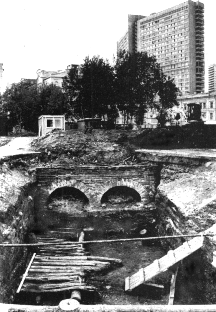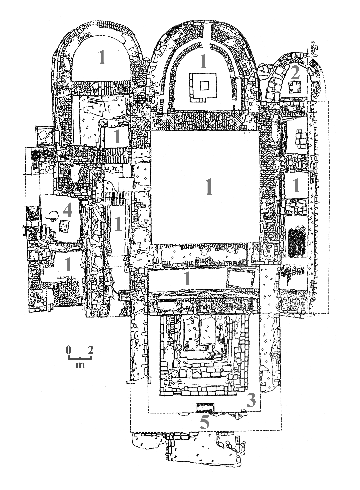free
trial issue
subscribe
back
issues
Athena Review, Vol. 1, No.3
Journal review: Russian Archaeology (Rossiiskaia
Arkheologiia)
A resurgence of interest in the Russian past is detailed in an article titled
"The Archaeology of Medieval Moscow: Recent Explorations (1980-1990s)," by
L.A. Beliaev and A.G. Veksler in the journal Rossiiskaia Arkheologiia
(Russian Archaeology) from issue 3, 1996, pp. 106-133. The following
review discusses major topics in this article.
Moscow in early Russian chronicles: In September of 1997, Moscow
celebrated the 850th anniversary of the first reference to the city in AD
1147 in the Ipatievskaya Chronicle, one of several medieval Russian
collective historical works. The earliest of these was the Primary
Chronicle, compiled by at least six different writer-editors. Begun by
Monk Nikon in Kievan Rus in the late 11th century, and completed by Monk
Nestor in AD 1118, the Primary Chronicle contains information on historic
and diplomatic events, as well as treaties, deeds, and prose records of heroic
legends. During the 9th and 10th centuries, Kiev became the first national
capital and controlled the Russian state. At that time Moscow was an obscure
and minor outpost. Moscow's AD 1147 mention in the slightly later
Ipatievskaya Chronicle thus marks the beginning of the city's place
in Russian history.
Marking this anniversary, Russian archaeologists have been conducting extensive
excavations in and around the city center of Moscow (fig.1). During the last
fifteen years the artifacts and architectural features thereby uncovered
have allowed a significantly improved understanding of medieval Russia. This
period has a distinct time frame and refers to different events than the
Middle Ages for Western Europe, which began in the 5th century with the fall
of the Western Roman Empire to the Germanic barbarians, and whose end corresponds
with the discovery and exploration of the New World in the 15th century.
The Russian Middle Ages, by contrast, began in the 9th century with the
establishment of the Rurik dynasty and ended in the 17th century when Peter
the Great ushered Western civilization into Russia.
 Several ancient
monasteries were excavated from the late 1970s to 1988, producing artifacts
from the 13th through 17th centuries. Investigations have revealed that 14th
century monasteries were built near estates of the nobility, many of whose
owners have been established. Some of the most interesting findings from
the Medieval period occurred in the areas of the Kremlin and Red Square.
In 1989-1993, the painstaking excavation of the Kazan Cathedral on Red Square
has permitted its faithful reconstruction. The same project uncovered the
first and only birchbark document ever found in Moscow. This unusual discovery
was the impetus for further work in church archaeology.
Several ancient
monasteries were excavated from the late 1970s to 1988, producing artifacts
from the 13th through 17th centuries. Investigations have revealed that 14th
century monasteries were built near estates of the nobility, many of whose
owners have been established. Some of the most interesting findings from
the Medieval period occurred in the areas of the Kremlin and Red Square.
In 1989-1993, the painstaking excavation of the Kazan Cathedral on Red Square
has permitted its faithful reconstruction. The same project uncovered the
first and only birchbark document ever found in Moscow. This unusual discovery
was the impetus for further work in church archaeology.
The Area around the Kremlin: During the Medieval period Moscow was
organized into several major sections, including the Kremlin, Kitay-gorod,
Beliy Gorod, Zemlyanoy Gorod, Zamoskvoreche, and the area known as the suburbs.
The most significant archaeological discoveries have been made in the area
of the Kremlin, the contemporary as well as historic city center.
[Fig.1: 1995 excavations on Arbatskaya ploschad in Moscow revealed
a 17th century street (L.A. Beliaev and A.G. Veksler 1996).].
The Kremlin, situated on a hill 125 feet above the level of the Moscow River,
contains many remarkable edifices within its walls, which housed the throne
and secular branches of government, as well as the church and the military.
Although every medieval Russian town boasts a kremlin (from the Mongol word
kreml meaning "fortress"), Moscow's Kremlin has a particularly rich history.
Founded in 1147 by Yuri Dolgorukiy, Prince of Moscow, the first fortress
was originally constructed of wood. Dolgorukiy's Kremlin, surrounded by wooden
houses, stables and churches, was sacked and burned to the ground during
the Mongol invasion in 1238. Yet Moscow's growth and development were virtually
unstoppable and the city soon recovered. The Kremlin, and the city which
surrounded it were rebuilt, and in 1339 it stood with fortifications made
of oak. These oak walls were replaced by stone some forty years later, and
it was because of the white color of these new walls that Moscow became known
as the "White City."
During Kremlin construction projects in 1988 and 1991, hoards of silver jewelry
were accidentally discovered by workers at two separate sites. Researchers
speculate that the treasure was buried in anticipation of the Mongolian invasion
of Batu Khan (grandson of Genghis Khan) in 1238, since no other burials of
this type, which predate the 12th to 13th centuries, have ever been uncovered
in Moscow. Although the contents of the hoards themselves are of great value,
even more historical significance is attached to their provenience, namely
the northeastern section of the Kremlin, near the 15th century wall. Placement
of the treasures is quite significant since this wall had not previously
been known to be connected with the pre-Mongolian era.
The Mongols controlled the Russian land for the next 200 years. During
the reign of Grand Duke Ivan III (1462-1505), Moscow continued to expand,
tripling in size, and was finally able to defeat the Mongols. In celebration,
Ivan III embarked on a vigorous building program, bringing in Italian architects
in 1472. In fact, many of the fortifications and cathedrals still standing
in Moscow today were designed and constructed by Italian architects and
engineers. Excavations revealed fragments of the first ornamental reliefs
used in these stone structures, dating from the end of the 15th to the early
16th centuries.
Kazan Cathedral and Red Square: Excavations at the site of the Kazan
Cathedral at Red Square revealed its original layout and its architectural
stratigraphy. The original Kazan Cathedral was constructed in 1636 in
commemoration of Tsar Mikhail Romanov's victory over the Poles, but was
demolished in the 1930s, and replaced by a sidewalk cafe and a park.
 The Cathedral
was dedicated to the Virgin of Kazan, and housed the precious icon of Our
Lady of Kazan. In 1993 the Cathedral was rebuilt using the results of
archaeological excavations and blueprints drafted by architect Pyotr Baranovskiy.
The Cathedral
was dedicated to the Virgin of Kazan, and housed the precious icon of Our
Lady of Kazan. In 1993 the Cathedral was rebuilt using the results of
archaeological excavations and blueprints drafted by architect Pyotr Baranovskiy.
[Fig.2: Excavations at Kazan Cathedral in 1991: 1) main cathedral,
north chapel, gallery, and bell tower, from 1636; 2) South Chapel, 1647;
3) 17th century steps; 4) 17-18th century food cellar; and 5) 18th century
dining room and porch. (L.A. Beliaev and A.G. Veksler 1996).].
Another excavation in the area of Red Square exposed ash and residue of a
1493 fire overlying a cultural layer of the 13th century. A well-preserved
but crude wooden dwelling built during the late 13th century was unearthed,
and served as an example of the architecture of this era. Fires were a constant
threat in Medieval Russia since most dwellings–belonging to both the
peasantry and nobility–were constructed of wood. Stone structures were
impractical in the cold Russian climate because of the condensation associated
with the tiled stoves used for heating. Such heating methods in wooden structures
had disastrous results. In fact, fires consumed dwellings so often that by
the 16th century Russians had devised a system of prefabricating wooden dwellings
which might be constructed and inhabited within the space of a week.
The Red Square excavation site also produced the first birchbark document
discovered in Moscow, a fragment of a legal text dating from the end of the
15th century. Such a find is highly unusual because Moscow's dry, oxidized
soil is not conducive to the preservation of birchbark, which occurs, in
most cases, in water-logged soil conditions, such as in the Russian city
of Novgorod.
The recent archaeological discoveries in Moscow have provided a wealth of
new data on Russian history. The attention being paid to rebuilding historical
monuments such as the Kazan Cathedral and the particular interest in the
Red Square excavations reflect Russia's desire to firmly establish its cultural
identity and find its place in the history of Western civilization.
(Reviewed by Marina Gore)
Athena Review Image
Archive™ |
Paleoanthropology in
the News
| Guide
to Archaeology on the Internet |
Free issue
|
Back issues
Main index of Athena
Review |
Subject Index
| Travel
Pages |
Galleries and
Museums |
Ad
rates |
Current issue
index |
Copyright © 1996-2001 Athena
Publications, Inc. (All Rights Reserved).
 Several ancient
monasteries were excavated from the late 1970s to 1988, producing artifacts
from the 13th through 17th centuries. Investigations have revealed that 14th
century monasteries were built near estates of the nobility, many of whose
owners have been established. Some of the most interesting findings from
the Medieval period occurred in the areas of the Kremlin and Red Square.
In 1989-1993, the painstaking excavation of the Kazan Cathedral on Red Square
has permitted its faithful reconstruction. The same project uncovered the
first and only birchbark document ever found in Moscow. This unusual discovery
was the impetus for further work in church archaeology.
Several ancient
monasteries were excavated from the late 1970s to 1988, producing artifacts
from the 13th through 17th centuries. Investigations have revealed that 14th
century monasteries were built near estates of the nobility, many of whose
owners have been established. Some of the most interesting findings from
the Medieval period occurred in the areas of the Kremlin and Red Square.
In 1989-1993, the painstaking excavation of the Kazan Cathedral on Red Square
has permitted its faithful reconstruction. The same project uncovered the
first and only birchbark document ever found in Moscow. This unusual discovery
was the impetus for further work in church archaeology.
 The Cathedral
was dedicated to the Virgin of Kazan, and housed the precious icon of Our
Lady of Kazan. In 1993 the Cathedral was rebuilt using the results of
archaeological excavations and blueprints drafted by architect Pyotr Baranovskiy.
The Cathedral
was dedicated to the Virgin of Kazan, and housed the precious icon of Our
Lady of Kazan. In 1993 the Cathedral was rebuilt using the results of
archaeological excavations and blueprints drafted by architect Pyotr Baranovskiy.